A shorter and tighter version of the following text has been included as a chapter in the book Offshoot: Contemporary Life Writing Methodologies and Practice, edited by Quinn Eades and Donna Lee Brien. Because my chapter in the book relates to my practices of blogging, I decided to experiment with composing the text here in WordPress. It’s a bit memoir-ish, a bit technology focused… At the time I didn’t publish the blog post, and it’s languished in my draft box ever since!
* * *
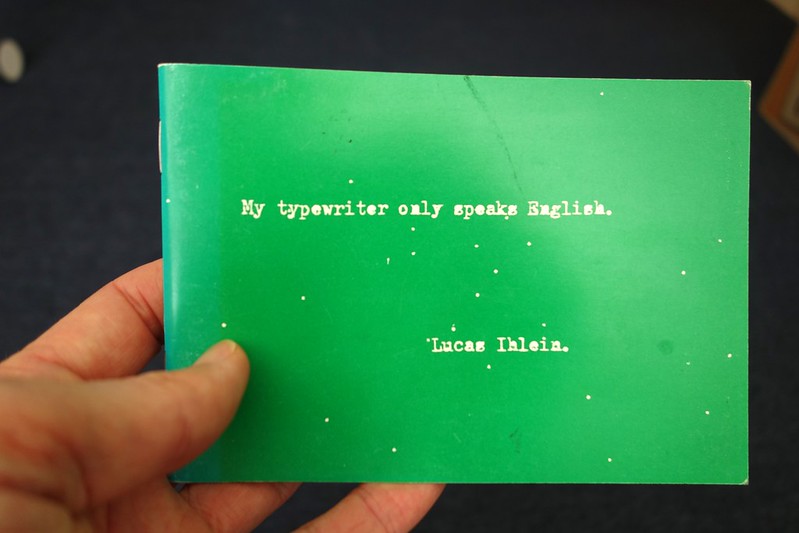
When I finished my undergraduate degree at the University of Western Sydney in 1996, I realised I had been in educational institutions continuously for 16 years. I had in my final years of university developed a very reflexive (and no doubt rather pretentious) “post-conceptual” form of art practice which focused on educational processes and technologies (lectures, seminars, information transmission, assessment etc). Clearly the context within which I spent most of my time had a big impression on the kind of work I was making. It was very dry and “critical”.
At the end of 1996, I decided it was time to quit all of this, and to make my way in the world beyond formal educational structures. I spent time working in a bookshop, painting walls in art galleries, kicking around on the dole. I consciously embraced “whimsy”, which had previously been a disallowed mode in my practice. This whimsy manifest itself in small everyday observations – scrappy drawings, transcribed dreams, found word sequences, and “poem-thingies” which I exchanged via the postal system with my friend and fellow artist Tim Hilton. A few examples:
*
SOMETHING QUITE CATHOLIC ABOUT THE SMELL OF A HOT GLUE GUN
*
His bellow resonates so powerfully that the water dances on his back.
*
after
a
night
of
drinking
in
the
red
light
district
with
Jason
and
Jeremy
I
pissed
in
the
bush
under
the
overpass
at
Newton
Circuit.*
Declaration: fear of varicose veins.
*
Even though they were whimsies, my poem-thingies still came with rules. A thought, once it arose, had to be written down, no questions asked. The immediate concern was the assiduous recording of whimsical thoughts, as well as micro-stories of experiences from my rather ordinary everyday life in suburban Sydney. Whether or not these were shown to anyone besides Tim was another matter. We did, occasionally, whittle down our productions into edited collections, which we printed off as zines at Kinkos.
From this daily practice I began to identify the value of accumulating small fragments. Tim and I did not have to “know” in advance what these fragments of life writing meant. Rather, once they were made, and gathered together, they might tell us something about ourselves. Even better, others might be able to tell us something about ourselves via the experience of reading our texts. In this way, knowledge could emerge in retrospect – which was a very different way of working from my previous attachment to didactic conceptual art traditions.
I found this method of working with accumulated fragments useful while working on various artist-in-residence projects in the late 1990s. In My Typewriter Only Speaks English (1998) for example, I spent a month in Singapore with 15 artists from Australia, Singapore and Hong Kong. We were working towards an exhibition at the Singapore Art Museum at the end of the month, and this fragmentary life writing approach enabled me to be open to whatever happened as I drifted around that city:
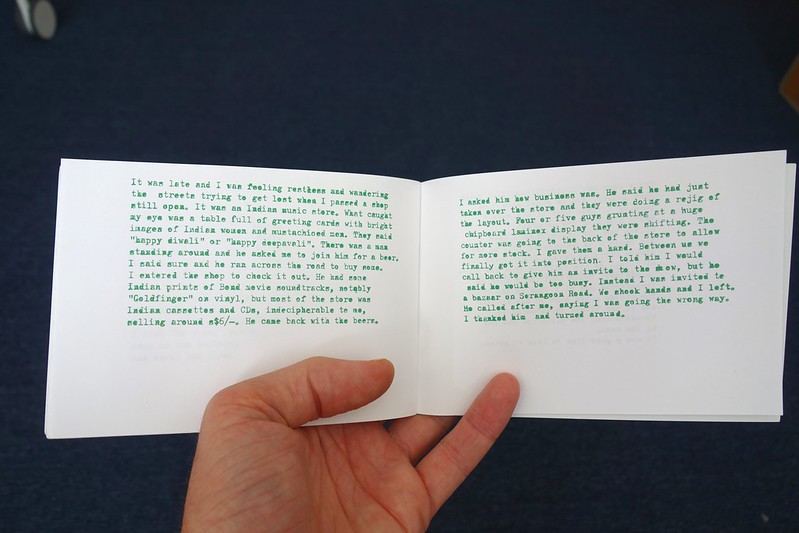
It was late and I was feeling restless and wandering the streets trying to get lost when I passed a shop still open. It was an Indian music store. What caught my eye was a table full of greeting cards with bright images of Indian women and mustachioed men. They said “happy divali” or “happy deepavali”. There was a man standing around and he asked me to join him for a beer. I said sure and he ran across the road to buy some. I entered the shop to check it out. He had some Indian prints of Bond movie soundtracks, notably “Goldfinger” on vinyl, but most of the store was Indian cassettes and CDs, indecipherable to me, selling around s$6-. He came back with the beers.
I asked him how business was. He said he had just taken over the store and they were doing a rejig of the layout. Four or five guys grunting at a huge chipboard laminex display they were shifting. The counter was going to the back of the store to allow for more stock. I gave them a hand. Between us we finally got it into position. I told him I would call back to give him an invitation to the show, but he said he would be too busy. Instead I was invited to a bazaar on Serangoon Road. We shook hands and I left. He called after me, saying I was going the wrong way. I thanked him and turned around.
It’s likely that if I had had access to blogs, I would have used them for this kind of work. But this was 1998, and easy online publishing via web 2.0 was still a few years away. Instead I used typewriters, scissors, sticky tape and photocopiers, and gave away my small self-published books and zines, or I incorporated them into self-service distribution systems within gallery installations. The smallness of these publications (usually A6 or A5) was important – I felt that they should not assert themselves spatially at a scale beyond their own modest ambition. If they occasionally contained some moments of quotidian poetic insight, this should be a small pleasure for the reader to discover, and not something shoved down their throats.
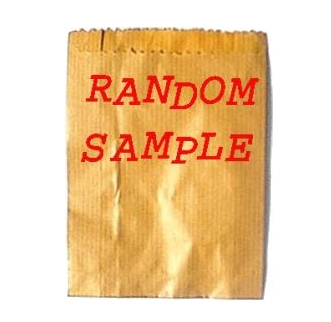
I attempted an online version this sort of work in 2000, with the project Random Sample. Working with my friend Geoff Webb, who is a web developer, I learned some basic HTML code and cobbled together an online publication which brought together a “random sample” of poem-thingies produced during travels to China, Italy, Spain, Austria, and England. In this work, I was trying to occupy the space of the browser window (which at that time was dominated by Netscape and Internet Explorer) as a page. (You can read a bit more about Random Sample here – although at the time of writing the actual site is no longer online).
I started blogging tentatively about my interests in art and everyday life in 2003, but it was not until 2005 that I found a way to integrate – and amplify – my quiet experiments in life writing using an overarching technological format. Bilateral Kellerberrin was a blog produced in a small wheat and sheep farming town in Western Australia. With this project, I discovered a tool which allowed me to intensify the experience of everyday life without fetishising it – and to share it with others.
It was actually rather simple. As with previous projects, I set myself a rule. In this case: write a blog entry each morning about whatever happened the day before in the town of Kellerberrin. Some additional rituals were helpful, like sitting down to write first thing in the morning, so that my recollections of the previous day were spewed out in a semi-conscious, just-woke-up state of mind. Sometimes memories were mingled with dreams:
I dream about “spitfires” – hairy caterpillars which form linear trails across the footpath. But the spitfires in my dream have formed a beard-shaped clump hanging from a tree. I run around asking people how to get rid of them.
As I write this, it’s raining. It started softly last night after midnight, but only enough fell to make a few small puddles. David Blair came by this morning with the key to the cinema (he’s finally changed the locks!) and said it wasn’t yet enough for the farmers to start up their seeding tractors. But shortly after he went on his bustling way, it began to fall again, light and sweet, the drops just drifting to the ground. Maybe this is, after all, the “opening rain” Pauline described, and which everyone has been waiting for.
– Kellerberrin Saturday 30 April 2005
What I loved about using the blog in this way is that it allowed two things to happen. First, it allowed me (and others) to track the development of relationships. Initial chance meetings with farmers or local residents in Kellerberrin might be briefly noted one day, and continually tracked, as friendships developed sporadically, sometimes awkwardly, throughout the two month lifespan of the project. Second, the blog technology generated a fast-turnaround feedback loop, which not only documented my everyday life in the town, but also frequently changed it. Some of the people I wrote about began to read the blog every day, and they would write comments in response, or bail me up in the street to adjust or correct my impression of our shared experiences. These feedback loops might lead to opportunities for future meetings in Kellerberrin, or nudge our nascent relationships along a bit. In this way, the blog was a useful tool for diaristic life writing, but it was also a tool which went beyond documentation, gently transforming my experiences of everyday life in the town. Here’s an example of my interactions around “Geoff the Taciturn Postmaster”, who became a minor character in the unfolding blog:
Kellerberrin Wednesday 4 May 2005
I picked up a bunch of packages from the post office. There is a tall man who works there, I have never learned his name.Donna Mak, May 5th, 2005 at 9:09 am:
I think that the tall man at the post office whom you don’t know the name of is Geoff Main. He’s the Keller postmaster – knows everything that goes on in town but maintains confidentiality and a code of silence better than most medical practitioners.Lucas, May 5th, 2005 at 12:14 pm:
Thanks Donna. Would you describe “geoff” (it must be him) as “taciturn”? I like the dictionary.com definition: “habitually untalkative” which is kind of taciturn in itself, don’t you think? Of course, you are right, he would know everything that goes on…perhaps he’s like the all-knowing shoeshine-boy in those Leslie Nielsen Naked Cop movies or whatever they’re called.Donna Mak, May 9th, 2005 at 8:56 am:
Taciturn would seem to be a reasonable description of Geoff. No doubt it’s a very useful trait in his line of work – I can’t imagine a garrulous postmaster surviving for long in a small town.
Kellerberrin Wednesday 18 May 2005
A breakthrough has been made with Geoff, the taciturn postmaster. It happened a few days back, when I was picking up mail, and Zed was paying a bill. Zed asked if we knew each other. Geoff said “yes, Lucas comes in to collect his mail.” So he knew who I was already, although we hadn’t been formally introduced! But now we are officially acquainted.I asked Geoff about the beautiful old post office building. There is still a flat upstairs, where he lives. You’ve gotta love this old fashioned simple way of doing things. I joked that there would be no excuse for him to be late to work. No fear, he’s an early riser: the mail from Perth arrives about seven, and he has to be up to help lug it in.
Yesterday, I bumped into Geoff again, in the newsagency. He said “Hello Lucas,” and I said “Hi Geoff.”
Kellerberrin Tues 24 May 2005:
At the post office, I asked Geoff if he had read the blog yet. He said yes. But he didn’t really agree with the way I had characterised him as “taciturn.” It was more that he was “shy,” he thought. Geoff was cool with it though: he understood that it was just my initial observation. In fact, he’s right. The more we meet, the more talkative Geoff has become. Perhaps, also, the word “taciturn” has an undertone of sternness which really isn’t there. It could be that Geoff was actually just being discreet (ie professional), in the early days of our acquaintance.
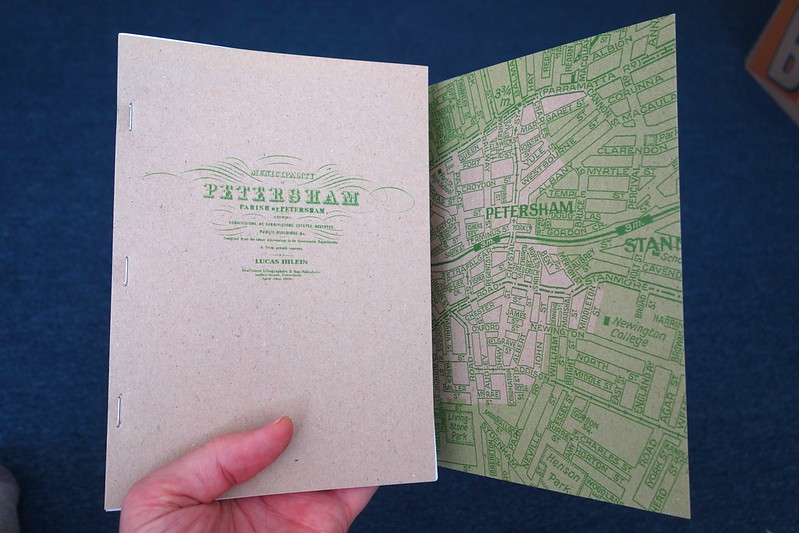
When I returned from Kellerberrin to my home in Petersham (suburban Sydney) the contrast between the two places was striking. My suburban life, if not exactly alienated, certainly lacked the fine-grained social connectiveness I had experienced in the small country town. This prompted me to wonder what might happen if I pursued the same process of blogging in Petersham as I had done in Kellerberrin. And so, precisely one year later, I began Bilateral Petersham – the “artist in residence in my own neighbourhood”:
beginning bilateral petersham, April 4 2006
For two months (well, a bit less actually) I will not leave the suburb borders of the mighty Petersham. Petersham is a smallish neighborhood in the “inner-west” of Sydney. It runs between Parramatta Road (at the north end) and Addison Road (at the south end), and is surrounded by such glamorous destinations as Leichhardt (North), Lewisham (West), Marrickville (South), and Stanmore (East). And I will remain entirely within it until the end of May, as (self-appointed) artist-in-residence of Petersham.
A city suburb is not a small country town, where folks stop and chat outside the chemist for twenty minutes before getting on with their day. I’ve been living in Petersham nearly two years now, and I know only a few of my nearest neighbours. I nod and smile at the folks in the deli, but they don’t know that my flatmate and me grew a great crop of tomatoes this year; that I had some art in an exhibition which opened last Saturday; that this last year I’ve been a gibbering emotional mess; that I’m studying for my PhD. They don’t even know that I can’t indulge in the Portuguese charcoal grilled chicken for which our main street is renowned. In the city, we somehow stay strangers for a very long time.
In Bilateral Petersham, I wanted to test whether the life-writing method involving daily blog feedback loops I had developed in Kellerberrin could be used as a tool for actively transforming my relationship to my own neighbourhood. The stakes were higher: unlike in Kellerberrin, I would not be leaving at the end of the project. In Petersham, there was more at risk in the integration of art and life, as I would be working within my own everyday landscape.
Re-reading the Bilateral Petersham blog ten years later, I am struck by how many friendships were seeded during that time. Because the project created a focus for honoring the ordinary and the local, it gave me (and those I encountered) a heightened awareness of the specialness of everyday life. This is not to say that everyday life had its quota of banalities and frustrations shucked away – those are recorded in abundance throughout the blog. However, it did seem to transform the experience of time. During the live period of the blog, time was released from its need to always be “used” towards a tangible outcome. For example, my first chance encounter with my neighbours “Tully and Heather” is typical:
I walked west down Canterbury Road, past the old Roller Rink, to look in the window of the barber shop. Maybe, I thought, I could kill two birds with one stone and have a shave in there. It’s a great old fashioned joint called “The Locals Barber Shop,” so I figure I qualify. But there were already two locals waiting for the solitary barber. My shave will have to wait for another day. I picked up some bananas from K.Jim’s fruit shop, and headed back up the road. Outside Sweet Belem, two “young people” were playing chess and eating pastry. They looked up and said Hi!, and asked if I’d like to join them. Sure, I said.
“I was just saying,” said the one whose name turned out to be Heather, “That one of the things I like is meeting strangers.” Tully, her companion, agreed. They were playing a local variation on chess. In their version, each time a move is made, you have to declare something that you like. And it can’t just be the name of a TV show or some pre-packaged product, it has to be something about it that you like, some connection you yourself have to the object of liking. Needless to say, I liked them both immediately. I settled in to watch them play.
The other pecularity about this game was that they were playing it sideways. Instead of the more aggressive frontal-attack style, Tully and Heather were experimenting with a more detatched, lateral approach. That way, you could see both sides, and appreciate the whole game, rather than being so partisan. We ordered second coffees, and Heather paid for them, seeing as I had (conveniently) just shelled out my last sheckles on toiletries.
Heather was taking a “mental health day” from her job as a sustainable transport planner. Tully is a procrastinating psychology student. He’s got two rather large essays to work on. One is about reading cognition and dyslexia. Something about how you can be: a good reader but a poor speller; a good reader and a good speller; a poor reader and a poor speller (obviously); but it’s extremely rare to find a good speller who is not also a good reader. It’s all to do with how you see words as shapes. Yes! I said. I love this kind of talk.
Heather and Tully went on to become my firm friends, and like many other followers of my blog, they capitalised on the currency of Bilateral Petersham to deepen their own relationships to our neighbourhood. There are hundreds of small encounters like this throughout the blog, many of which lead nowhere, but contribute to the overall texture of the work. Although the daily writing ritual built up an amount of words (90,000) equivalent in length to a novel, there is no master-planned narrative arc, and the project’s rules (stay in your own suburb for 2 months; write a blog entry each day) do not permit post-hoc editing for cohesion. Rather, the experience of reading and writing in Bilateral Petersham is of an accumulation of small textual vignettes and fragments. This accumulation brings Bilateral Petersham into being as a living, breathing ecology – a written environment – constantly changing over time, surging and subsiding in intensity, in tune with the waxing and waning of my own energy, and the attentive engagement of my readership/audience.
If, at the beginning of the project, I had expressed doubts about the capacity of blogging as a means of changing one’s everyday local life, by the end of the two month period these doubts had dissipated:
Things are piling up behind me, a wave of events and meetings and memories that seems to swell up, ready to crash. As I come towards the end of my period of self-imposed suburban lockdown, connections are leading to further connections, first-time meetings are rolling over into follow-ups, which slowly become…relationships? These second, third, fourth meetings develop a more easy casual flow. Perhaps some sort of rapport begins to build. Or maybe it’s trust. As I walk around the neighbourhood, it’s rare not to wave and say hi to somebody I’ve met through this project.
Sure, I’m getting busier as more meetings and connections come together, and as the contacts I’ve made begin to overlap and interconnect.
But there’s no sense of urgency. There’s no need to get “everything” done by the end of May. As you may have noticed, I’ve become less anxious about documenting every damn interaction which takes place. Some meetings, some things just exist for themselves. They stay with me, maybe I’ll tell you about them face to face. Maybe they’re secrets I’m entrusted to keep. Maybe they’re just not translatable to text. Maybe I’m too tired to remember them until later. Or maybe I don’t even have the capacity to recognise them consciously.
But when Bilateral Petersham “ends”, I’ll still be here. I’ll wake up on the first of June and the project will be over, but I’ll still go down to Charlie’s Deli for my milk. I’ll continue to hang out at the bowling club, and I certainly hope I get invited to more games nights at Janine’s. Wolfie and I will still potter around the ‘hood. The “artwork” will be done, but my life will have changed. Then what?
-Then What, May 20th, 2006
Before I finish these reflections on my own experiments in life writing as a form of art, I have two points to make, both of which might seem fairly obvious. The first relates to the idea, as I’ve already discussed above, that ritualised daily life writing is more than an authentic account of reality. I was reminded of this while working on Bilateral Petersham, when a friend referred me to the writing of Samuel Pepys, an English Member of Parliament and prolific diarist who lived in London from 1633-1703. Pepys’ prodigious diary – which is current between 1660-69, has been an extremely important primary document for historians researching events in England during that period. However, literary historian Harry Berger Jnr argues that Pepys’ diary goes beyond its widely accepted function as an authentic, mimetic “document” of events taking place in London in the 1660s. This is not just because the reflexive framework that a diary imposes on its writer creates a layer of self-consciousness over life’s experiences, all of which became “grist for that mill” – the impact goes deeper than that. As Berger Jnr speculates:
If he became habituated to the project so that it was part of his daily agenda, wouldn’t that have some influence over the selection and conduct of the daily pursuits he planned to write about? […] Perhaps the diarist is already a collector when he takes his net out into the field of daily pursuits; perhaps the life recorded in the diary is a life lived for the diary, a life lived in expectation of writing about it, a life monitored to ensure the provision of collectable and writable experiences in the ongoing project of self-collection through self-representation. Such a project might be imagined to place the subject as referent in the position of performing for the benefit of the subject as writing agent […] (Berger Jnr, p. 579).
In the end, as Berger Jnr says, Pepys “selectively lives a “writable life” (p. 585). To make such an assertion is to nudge Pepys, the main subject of the diary, towards the direction of a “character”, and to nudge the diary itself towards the direction of fiction. This complicates the function of the text as a reliable historical record. Similarly, with Bilateral Petersham, the project’s rule framework made it likely that a “writable life” would be produced, at least during the project’s allocated timeframe. As a lifewriting medium, the blog was the means through which its main character subjects co-emerged. As I wrote at the conclusion of the project, throughout that two months, and via those 90,000 words, “Petersham and I, suburb and citizen, brought each other into being”.
The second concluding point I want to make is about the technology of the blog medium itself. As I mentioned above, blog software was not widely available in the late 1990s when I was working on projects like My Typewriter Only Speaks English. The uptake of blogging began in earnest in the early 2000s, with platforms like Blogger and LiveJournal, and this early phase was characterised by personal, diaristic usage, particularly for amateur life-writing (see Serfaty, 2003). There was strong growth in blogging between 2005 and 2006, when I was working on Bilateral Kellerberrin and Bilateral Petersham. Between the time that I carried out the two blog projects there was a worldwide quadrupling in the number of blogs on the internet – from approximately 8 million in April 2005, to more than 32 million by April 2006 (Sifry 2007).
This growth corresponded with broader social awareness of what a blog is, and how it functions. This was, of course, an important factor for my projects which sought to engage with audiences both online and offline. In practice, I experienced this exponential growth as a broader acceptance and easier uptake of the second of these two projects, and a corresponding increase in the quantity of blog readers who felt confident to participate by contributing comments and dialogue online. In other words, the continual growth in blogging across society in general means that at the time of making, my two projects afforded very different experiences, even though they used the same medium.
In the years since Bilateral Petersham, blogging intensified, and then fragmented. The rise of “microblogging” platforms like Twitter, Facebook, Instagram and Tumblr has shifted internet users’ attention away from the “traditional” of text based, personal blogging. As an artist working on Bilateral Kellerberrin in 2005, one of my tasks was to teach my local audience – many of whom had never heard of this medium – how to read and write comments on my blog. Blogging was a form of “new media” – it seemed exciting, and in the pre-Facebook world, it was a key source of regularly updated local knowledge. I used the term “Bilateral Blogging” to describe the method I used in my projects, because it characterised the negotiated relationship between writer and reader (Ihlein, 2007). By contrast, the fragmentation of the web – and to a large extent the dominance of micro-blogging by large corporations – means that the one to one relationship implied by the term “bilateral blogging” is no longer appropriate. The world of self-publishing on the web is now a shimmering multifarious organism, far more complex than it was a decade ago.
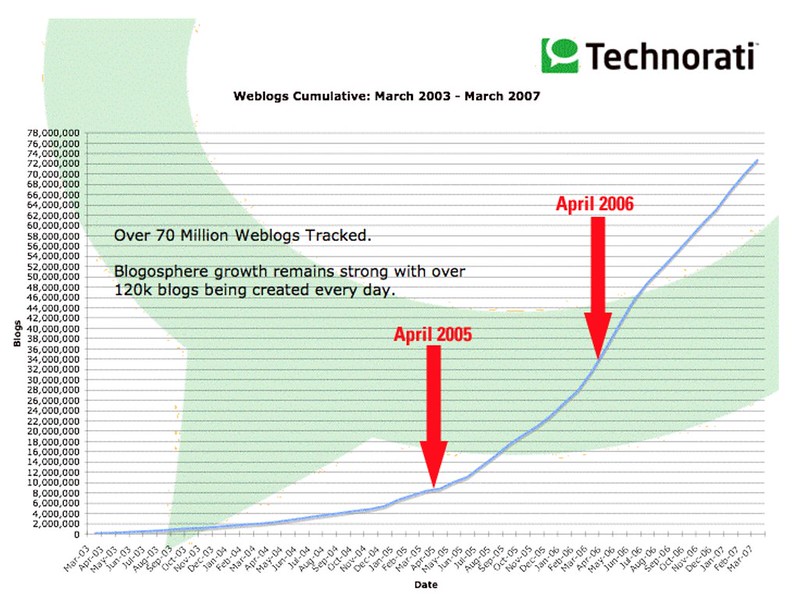
YES! I just came back to your old blog after reading the chapter last week!
It’s really nice to look back on that time of postgraduate arting and writing…